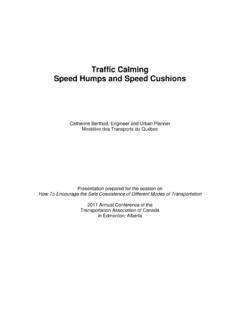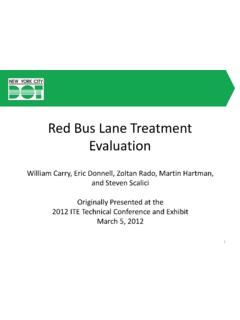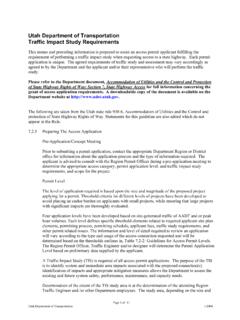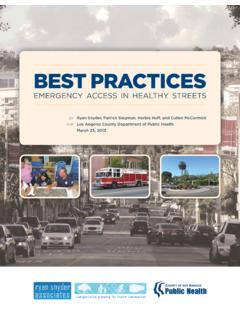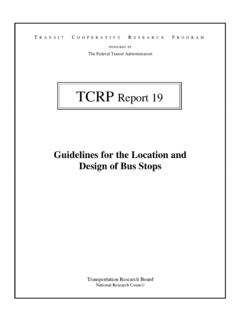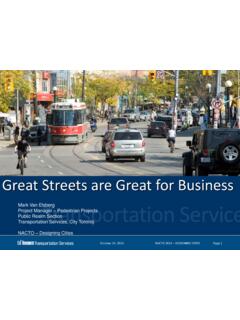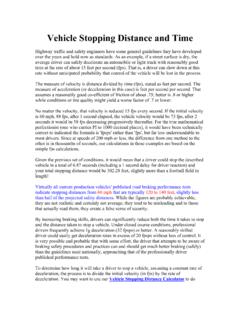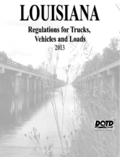Transcription of Updated Guidelines for the Design and Application of Speed ...
1 Updated Guidelines for the Design and Application of Speed Humps Margaret Parkhill, , Rudolph Sooklall, , Geni Bahar, Abstract Speed humps have gained acceptance as a traffic calming device by North American and international jurisdictions. However, Design and Application varies widely between jurisdictions, and Speed humps often meet resistance from residents and road users. In 1997, the Institute of Transportation Engineers (ITE) published a Recommended Practice for the Design and Application of Speed humps. The recommended practice is now being Updated to provide state-of-the-practice Guidelines for Speed humps and Speed tables. To update the ITE Speed humps recommended practice, the experiences of agencies implementing Speed humps were obtained through an extensive literature review. The literature review was supplemented with an online survey targeting North American and international jurisdictions. This paper provides an overview of the recommended framework for an agency to follow to implement Speed humps or Speed tables in their jurisdiction.
2 This framework is based on the experience documented by dozens of agencies. The framework includes: Develop and follow a formal public consultation process; Determine the needs of the street or neighborhood; Construct and maintain Speed humps; and Monitor and evaluate Speed hump effectiveness. 1. INTRODUCTION Speed humps are one tool available in the traffic calming toolbox, and have gained acceptance by North American and international jurisdictions since their development in the early 1970s by the Transport and Road Research Laboratory (TRRL) in Great Britain. However, Design and Application varies widely between jurisdictions, and Speed humps often meet resistance from residents and road users. In 1997, the Institute of Transportation Engineers (ITE) published a Recommended Practice for the Design and Application of Speed humps. Research has been conducted and lessons have been learned through experience regarding the Design and implementation of Speed humps since the publication of this guideline.
3 As a result, ITE initiated an update to the Recommended Practice to provide state-of-the-practice Guidelines for the Design and Application of Speed humps. State-of-the-practice Guidelines were obtained through an extensive literature review on relevant published material. The knowledge base gained from the literature review was supplemented through an on-line survey of jurisdictions implementing Speed humps. The on-line survey was designed to capture 2information to fill the knowledge gap from the literature review. Jurisdictions in the United States, Canada, and internationally provided their experiences; close to 300 responses to the survey were received. Guidance was also provided by an ITE Technical Advisory Committee (TAC) whose members have extensive experience in Speed hump Design and implementation. The update is currently under review, and is expected to be published later this year. This paper provides an overview of the recommended framework for an agency to follow to implement Speed humps or Speed tables in their jurisdiction.
4 This framework is based on the experience documented by dozens of agencies. The framework includes: Develop and follow a formal public consultation process; Determine the needs of the street or neighborhood; Construct and maintain Speed humps; and Monitor and evaluate effectiveness. Other common Speed control measures currently used by various agencies are documented in ITE s Traffic Calming: State of the Practice . (Ewing 1999) Speed humps vs. Speed bumps A Speed hump is a raised area in the roadway pavement surface extending transversely across the travel way. Speed humps are sometimes referred to as pavement undulations or sleeping policemen . Most agencies implement Speed humps with a height of 3 to inches (76 to 90 mm) and a travel length of 12 to 14 feet ( to m). Speed humps are generally used on residential local streets. A Speed bump is also a raised pavement area across a roadway. Speed bumps are typically found on private roadways and parking lots and do not tend to exhibit consistent Design parameters from one installation to another.
5 Speed bumps generally have a height of 3 to 6 inches (76 to 152 mm) with a travel length of 1 to 3 feet ( to 1 m). From an operational standpoint, Speed humps and bumps have critically different impacts on vehicles. Within typical residential operational Speed ranges, vehicles slow to about 20 mph (32 km/h) on streets with properly spaced Speed humps. A Speed bump, on the other hand, causes significant driver discomfort at typical residential operational Speed ranges and generally results in vehicles slowing to 5 mph or less at each bump. Speed bumps of varying Design have been routinely installed on private roadways and parking lots without the benefit of proper engineering study regarding their Design and placement. Speed humps, on the other hand, have evolved from extensive research and testing and have been designed to achieve a specific result on vehicle operations without imposing unreasonable or unacceptable safety risks.
6 Speed tables Speed tables are essentially flat-topped Speed humps, and may have a textured material on the flat section with asphalt or concrete for the approaches. Speed tables are sometimes referred to as trapezoidal humps or Speed platforms . If marked as a pedestrian crossing , Speed tables may also be referred to as raised crosswalks or raised crossings . Most agencies implement Speed tables with a height of 3 to inches (76 to 90 mm) and a travel length of 22 feet ( m). Speed tables generally consist of 10 foot ( m) plateau with 6 foot ( m) approaches on either side that can be straight, parabolic or sinusoidal in profile. The longer lengths of Speed tables provide a gentler ride than Speed humps and generally result in vehicle operating speeds ranging from 25 to 30 mph (40 to 48 km/h) on streets depending on the spacing between Speed tables. Speed tables are generally used on residential collectors, emergency routes or transit routes.
7 The City of Portland, OR has designed split Speed tables for designated emergency routes. Split Speed tables are also 22 feet ( m) long and extend from curb to centerline on opposite sides of the street. Split Speed tables are separated by a longitudinal gap that allows fire trucks to weave around the split Speed humps in slalom-like fashion. The Portland Department of Transportation is currently testing this alternative Speed table Design . Split Speed tables are not included in this paper. 2. PUBLIC CONSULTATION PROCESS Traffic calming activities are carried out to reduce traffic speeds and volumes. Based on the experience of most agencies, it is critical to obtain the support of a substantial majority of all residents in a neighborhood targeted for traffic calming measures, including Speed humps, prior to implementation. Therefore, it is important for agencies to develop a working relationship with communities and have well defined administrative procedures in place.
8 Based on a survey of agencies in North America and around the world, the large majority of agencies (77%) have a formal public consultation process for implementing Speed humps. It is recommended that each agency, prior to installing Speed humps, develop a formal process for Speed humps. Five key elements are recommended: 1. Appropriate legislation (policies, ordinances and regulations); 2. Request procedure; 3. Evaluation of requests; 4. Consultation (with the public and other agencies); and 5. Removal procedure. Appropriate legislation Statutory authority, constitutionality, and tort liability are the legal issues surrounding Speed hump installation that jurisdictions should take into consideration. A jurisdiction must have the legal authority to implement Speed humps on a given class of roadways, while respecting the 4constitutional rights of affected landowners and road users, and minimizing the risks to road users. (Ewing 1999) Before initiating a Speed hump installation program, it is recommended that appropriate policies, regulations, and/or ordinances are developed to govern elements such as the community involvement process, hump Design and location criteria, cost sharing relationships, installation and maintenance requirements, and evaluation/modification procedures.
9 It is also important to clearly define the project area, that is, the area expected to be affected by Speed hump implementation. For example, any property located within 250 feet (76 m) from the first and last Speed humps is considered by the City of Beaverton (OR) to be part of the project area. It is important that jurisdictions review state and municipal ordinances and regulations to ascertain if existing legislation could affect the implementation of Speed humps. Existing legislation may have to be modified, or new legislation developed, before proceeding with Speed hump installation (TAC 1998). Request procedure Speed hump installation may be requested by a single resident, though additional support from the community is generally needed at a later stage in the process for the project to remain eligible. The request procedure should clearly outline the expectations of all potentially impacted parties and the timing of their participation in the various stages of the process.
10 The following components are recommended for inclusion into a Speed hump request procedure: Develop a request or petition form which residents can use to request Speed humps in their neighborhood. Many agencies have petition forms available on the internet, which residents can download, collect signatures, and return to the appropriate department; Identify the department that will be responsible for receiving Speed humps requests and coordinating the overall process; Screen all requests received to determine eligibility. Common eligibility criteria include the 85th percentile Speed , the posted Speed limit, and the average daily traffic. Some agencies also require support from a certain number or percentage of affected residents in order for a request to be eligible; and If a request meets all eligibility requirements, obtain wider community support before proceeding to the evaluation stage. Define the project area for the Speed hump request in order to determine who to include in the process.

